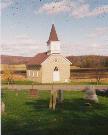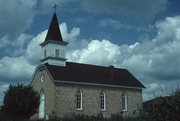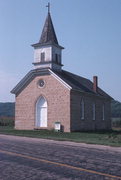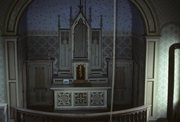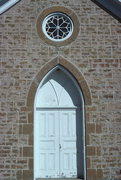| Additional Information: | A 'site file' exists for this property. It contains additional information such as correspondence, newspaper clippings, or historical information. It is a public record and may be viewed in person at the Wisconsin Historical Society, Division of Historic Preservation.
Our Lady of Loretto recalls the piety of the German immigrants who left Baden, Bavaria, and the Rhineland and settled in Sauk County. Aided by the Reverend Adelbert Inama, they established this church in 1854 as a mission of Sauk City’s St. Aloysius parish. First they built a log structure, but when it burned down they replaced it with this yellow limestone edifice. Lancet openings at the windows and the door, lancet vents in the steeple, and a rose window above the entrance typify the folk expression of the Gothic Revival style. Local stonemasons Mettel and Allart constructed the church’s walls of limestone rubble, overlaying the irregularly coursed stonework with raised beads of mortar to simulate ashlar or square-cut masonry. At the corners they laid dressed limestone quoins to solidify the structure. Papers found in the cornerstone indicate that William Dresen of Sauk City was the carpenter and joiner.
Our Lady’s interior is one of the few original Catholic church interiors to survive in Wisconsin. Erhard Brielmaier’s Milwaukee-based firm built the Gothic altar, ornamenting it with lancet arches, turned finials, and quatrefoils. The walls and ceiling, painted pink, gold, and blue, are stenciled with stars, crosses, fleurs-de-lis, stylized tulips, urns, and other motifs; the artist's name is unknown. Among the faded German inscriptions on the walls is at least one of the Ten Commandments. The Sauk Prairie Area Historical Society, which owns the building, recently completed a major art conservation project. |
|---|
| Bibliographic References: | WISCONSIN STATE JOURNAL, 1D, 8/7/1995.
FORT ATKINSON DAILY JEFFERSON COUNTY UNION 8/18/1995.
RHINELANDER DAILY NEWS 8/11/1995.
SAUK CITY SAUK PRAIRIE STAR 8/10/1995.
JANESVILLE GAZETTE 8/12/1995.
MILWAUKEE JOURNAL SENTINEL 8/13/1995.
EAU CLAIRE LEADER TELEGRAM 8/27/1995.
SAUK CITY SAUK PRAIRIE STAR 7/13/1995.
PORTAGE DAILY REGISTER 7/14/1995.
SAUK CITY SAUK PRAIRIE STAR 9/12/1996.
SAUK CITY SAUK PRAIRIE STAR 6/6/1996.
The Capital Times 10/20/1998.
Sauk Prairie Eagle 8/8/2001.
Baraboo News Republic 6/5/2002.
Buildings of Wisconsin manuscript.
Perrin, Richard W. E., Historic Wisconsin Architecture, First Revised Edition (Milwaukee, 1976). |
|---|

